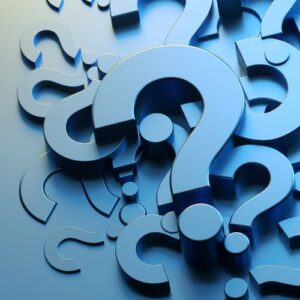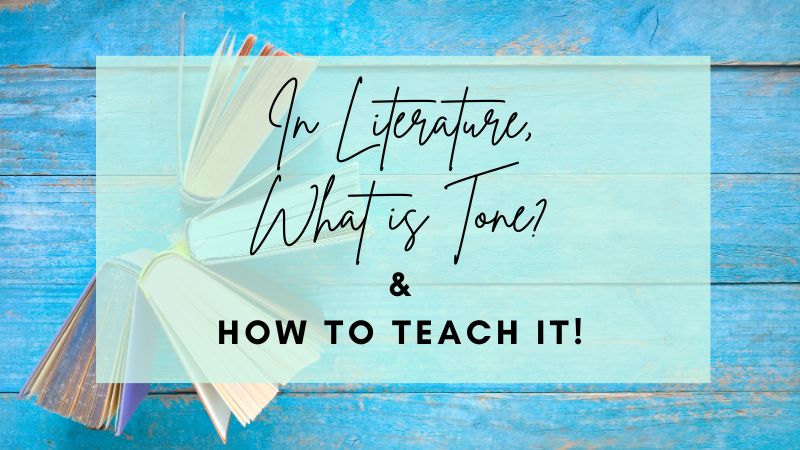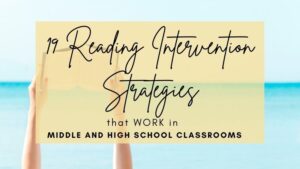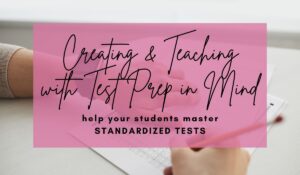Tone is one of those terms that seems so simple, but is so hard to teach! In Literature What Is Tone seems to be the question asked all of the time!
Because all of our students come from different backgrounds with diverse experiences, teaching the concept of tone can be quite challenging. Quite simply, tone is the author’s, narrator’s, speaker’s, or character’s emotions while speaking. The thing is, identifying tone is not easy. Answering the question In Literature What Is Tone? can be almost impossible to teach at times!
There are so many steps to examining and analyzing tone; however, there is one thing we do know. Teaching tone is vital, because students will encounter tone at their jobs, in college, and even in their homes. Plus, every standardized test will ask students about tone. Ultimately, we want to prepare our students to recognize tone in a variety of contexts. This goal can only be achieved with tons of practice!
Therefore, we will begin this discussion by asking, “In literature what is tone?”
Need help with Test Prep? Check out this FREE Pack of 3 Test Prep Activities to help students achieve success on standardized tests!
In Literature What Is Tone? This question is more than what it seems!

Tone is the emotion of the creator. It can come from the author. Or it can come from the narrator as an embodiment of the speaker. It can also connect to one of the speakers in the piece of literature or even a specific character. It really depends on the type of literature, how it was written, and why it was written.
There is a clear equation for answering the question In Literature What is Tone? and determining the overall tone!
Tone
DICTION + CONTEXT + MEANING = TONE
Let’s break down each term to help answer the question In Literature What Is Tone?!
Diction
Diction is word choice. We all choose words to convey our meaning and purpose. We must encourage our students to pay attention to diction when questioning In Literature What Is Tone?
Context
Context refers to settings, time periods, and situations surrounding the text. It can relate to the actions and events in the text itself or what is going on outside of the text in the world of the author.
Meaning
We have to ask ourselves as well as our students: What is the meaning, significance, or importance of the phrase, sentence, paragraph, page, chapter, entire passage, etc. If we don’t interpret the meaning correctly, the tone can be misunderstood. Interestingly, a reader might misinterpret the tone and could therefore misinterpret the meaning.
GENRES: In Literature What Is Tone?
There are so many genres that encompass literature or literary texts, which can help answer the question In Literature What Is Tone?! The tone, therefore, can vary depending on the diction or word choice within a piece of literature. Most importantly, when teaching tone, we need our students to see tone from beginning to end. Shift happens! If a character learns a lesson, the tone will change.
If the speaker in a poem has a revelation, the tone will vary. We must expose our students to every type of literature we can, so they feel more and more confident asking In Literature What Is Tone? and analyzing tone in different situations.
- Poetry
- Narratives
- Short Stories
- Plays
- Novels
- Songs
Click to read “19 Reading Intervention Strategies that WORK in Middle and High School Classrooms!”
The Difference Between Connotation and Tone
Connotation is the feeling, either positive or negative, created by the diction.
For example, when you walk into a clothing store, you might see a “Plus Size” section. Please note: it is not the fat, heavy, or obese section.* And why don’t we call it any of these other terms? Well, because no one would step foot in that area. These words have negative connotations to them, even though they describe similar states of being.
Similarly, we have words to describe food that have more positive meanings that might be used in an ad. For instance, would you rather have a “tasty,” “delectable,” “delicious,” or “scrumptious” burger? I don’t know about you, but I prefer the words that will make me salivate. “Tasty” is fine, but it does not have the same level of positivity as the other words.
Most importantly, we need our students to see the distinction between tone and connotation. If I see ONE more student write that the tone is POSITIVE or NEGATIVE, I might just pull my hair out….or I might just take the time to review this skill one more time 🙂
Activities for Teaching Tone in Literature
1. Tone Words Games
- Would You Rather? for the question In Literature What Is Tone? You can use descriptions with a specific set of tone words for students to choose from! They might even compete to describe various situations or products in ads and have a vote!
- Tone Scales: Pass out a variety of tone words all connected in some way. Encourage students to arrange the tone words by level of emotion.
- Ex. uncomfortable, upset, frustrated, angry, irate, infuriated
- Ex. peaceful, calm, lethargic, lazy, complacent
- Faces & Tones: You could have students find images with different emotions. Let students have fun coming up with tone words and create stories behind the pictures!
2. Tone in Writing
Of course, we want students to write all of the time. Practice makes better, especially when asking In Literature What Is Tone?! A quick short response connected to tone can help students examine tone and how to support their ideas about tone!
See the example below from a Paired Passages Words & Phrases Lesson!
Short Response: Based on the following quotation, what is the speaker’s tone towards Johnny in Passage 2? Use evidence from the excerpt to support your ideas.
“Let love and friendship on that day,
Hurrah, hurrah!
Their choicest pleasures then display,
Hurrah, hurrah!
And let each one perform some part,
To fill with joy the warrior’s heart,
And we’ll all feel gay when Johnny comes marching home”
SAMPLE RESPONSE
Want help with Test Prep? Check out “13 Effective Ways to Integrate TEST PREP into Your Classroom!”
3. Tone for Test Prep
An easy way to have students prepare for state tests is through integrating test prep! Why not have students kill 2 birds with 1 stone?
Check out the example questions and answers to help with the question In Literature What Is Tone? below from a Paired Passages Words & Phrases Lesson!
This question has 2 parts.
Part A: What is the youth’s tone towards the prospect of fighting in Passage 1?
A. Uncertain
B. Annoyed
C. Appalled
D. Ecstatic
Part B: Which 2 quotations from Passage 1 support your answer to Part A?
□ “The youth was in a little trance of astonishment”
□ “He had, of course, dreamed of battles all his life”
□ “In visions he had seen himself in many struggles”
□ “The smoke from the fire at times neglected the clay chimney of clay and wreathed into the room”
□ “He could not accept with assurance an omen that he was about to mingle in one of those great affairs of the earth”
□ “There was a portion of the world’s history which he had regarded as the time of wars, but it, he thought, had been long gone over the horizon and had disappeared forever”
Want other activities for helping to answer the question: In Literature What is Tone?
One Note: In Literature What Is Tone? Tone is NOT Mood
We know tone is not the same as mood. When teaching tone and answering In Literature What Is Tone? we can focus on tone as connected to the creator. When teaching mood, we can recognize that the connection is to the audience. That is the most basic way to look at it. I hope this discussion helps as you venture into teaching tone to your students!
Need some help with test prep? Read the blog post: Reading Comprehension High School Worksheets: Creating and Teaching With Test Prep In Mind!
For more activities, quizzes, and lesson ideas to answer the question In Literature What is Tone? Integrated ELA Test Prep!
Want help with Test Prep? Check out “13 Effective Ways to Integrate TEST PREP into Your Classroom!”







